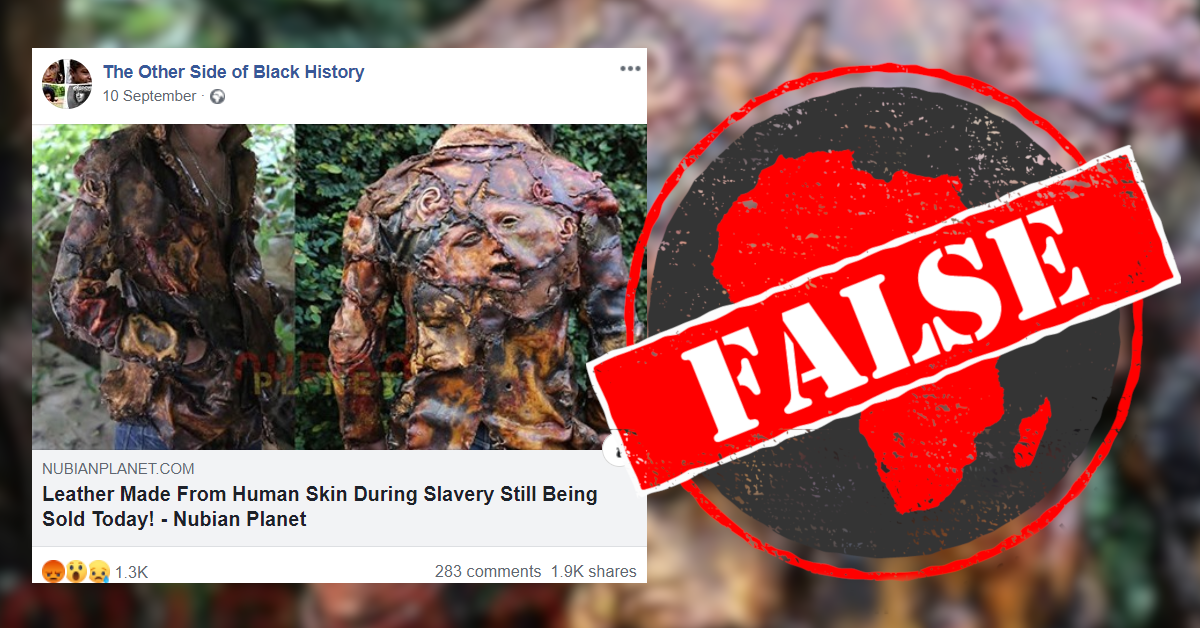“Leather made from human skin during slavery still being sold today!”
That’s the headline of an article on the website Nubian Planet, dated 14 November 2019.
It’s been shared more than 52,000 times on Facebook, according to the social network’s fact-checking system, and on at least one other website.
The article and its Facebook preview show a man wearing a jacket that seems to be stitched together from the skin of people’s faces.
“African slaves were often killed for their skin to make human leather for shoes and clothing,” the article reads.
“But if you're Black and celebrate your history, it is fine as long as you don't mention these practices because there are plenty of stores that exist today that sell products made from human skin.”
Is the jacket made from human skin? We checked.

A reverse image search reveals that the jacket is actually made of latex. (Latex is a rubbery kind of plastic.)
It’s part of a creepy clothing brand inspired by US serial killer Edward Gein, who was known for grave robbery and murder in the 1950s. Gein would use human body parts to make household items, clothes and masks.
He was charged with murder and pleaded not guilty for reason of insanity. Later, he was diagnosed with schizophrenia and confined to a mental clinic for the rest of his life. Gein died in 1984.
In 2017, artists Kayla Arena and Toby Barron created the disturbing clothes – which include hats and shoes – that look like they are made from human skin. They called their line of clothing “Ed Gein inspired”.
The jacket is plastic, not human skin. – Jennifer Ojugbeli
That’s the headline of an article on the website Nubian Planet, dated 14 November 2019.
It’s been shared more than 52,000 times on Facebook, according to the social network’s fact-checking system, and on at least one other website.
The article and its Facebook preview show a man wearing a jacket that seems to be stitched together from the skin of people’s faces.
“African slaves were often killed for their skin to make human leather for shoes and clothing,” the article reads.
“But if you're Black and celebrate your history, it is fine as long as you don't mention these practices because there are plenty of stores that exist today that sell products made from human skin.”
Is the jacket made from human skin? We checked.

Leather designs inspired by serial killer
A reverse image search reveals that the jacket is actually made of latex. (Latex is a rubbery kind of plastic.)
It’s part of a creepy clothing brand inspired by US serial killer Edward Gein, who was known for grave robbery and murder in the 1950s. Gein would use human body parts to make household items, clothes and masks.
He was charged with murder and pleaded not guilty for reason of insanity. Later, he was diagnosed with schizophrenia and confined to a mental clinic for the rest of his life. Gein died in 1984.
In 2017, artists Kayla Arena and Toby Barron created the disturbing clothes – which include hats and shoes – that look like they are made from human skin. They called their line of clothing “Ed Gein inspired”.
The jacket is plastic, not human skin. – Jennifer Ojugbeli
Republish our content for free
For publishers: what to do if your post is rated false
A fact-checker has rated your Facebook or Instagram post as “false”, “altered”, “partly false” or “missing context”. This could have serious consequences. What do you do?
Click on our guide for the steps you should follow.
Publishers guideAfrica Check teams up with Facebook
Africa Check is a partner in Meta's third-party fact-checking programme to help stop the spread of false information on social media.
The content we rate as “false” will be downgraded on Facebook and Instagram. This means fewer people will see it.
You can also help identify false information on Facebook. This guide explains how.


Add new comment